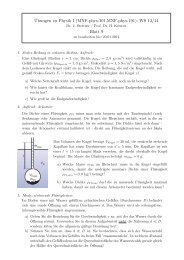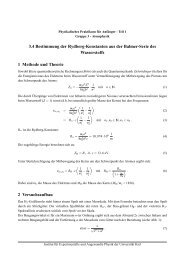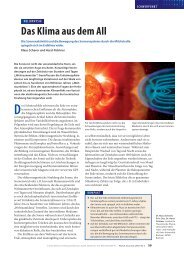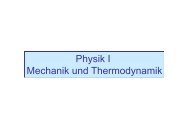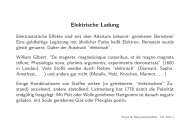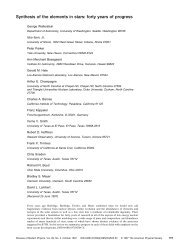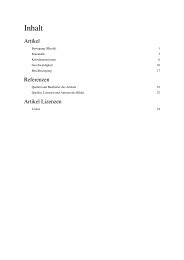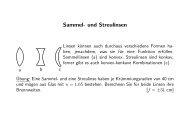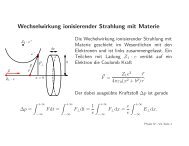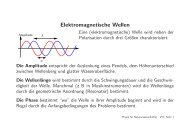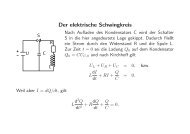Obliquely Propagating Dust-Density Plasma Waves in the Presence ...
Obliquely Propagating Dust-Density Plasma Waves in the Presence ...
Obliquely Propagating Dust-Density Plasma Waves in the Presence ...
You also want an ePaper? Increase the reach of your titles
YUMPU automatically turns print PDFs into web optimized ePapers that Google loves.
PRL 97, 205009 (2006)<br />
PHYSICAL REVIEW LETTERS week end<strong>in</strong>g<br />
17 NOVEMBER 2006<br />
<strong>Obliquely</strong> <strong>Propagat<strong>in</strong>g</strong> <strong>Dust</strong>-<strong>Density</strong> <strong>Plasma</strong> <strong>Waves</strong> <strong>in</strong> <strong>the</strong> <strong>Presence</strong> of an Ion Beam<br />
A. Piel,* M. Kl<strong>in</strong>dworth, and O. Arp<br />
IEAP, Christian-Albrechts-Universität zu Kiel, D-24098 Kiel, Germany<br />
A. Melzer and M. Wolter<br />
Institut für Physik, Ernst-Moritz-Arndt-Universität Greifswald, D-17489 Greifswald, Germany<br />
(Received 24 August 2006; published 17 November 2006)<br />
Self-excited dust-density waves are experimentally studied <strong>in</strong> a dusty plasma under microgravity. Two<br />
types of waves are observed: a mode <strong>in</strong>side <strong>the</strong> dust volume propagat<strong>in</strong>g <strong>in</strong> <strong>the</strong> direction of <strong>the</strong> ion flow<br />
and a new mode propagat<strong>in</strong>g obliquely at <strong>the</strong> boundary between <strong>the</strong> dusty plasma and <strong>the</strong> space-charge<br />
sheath. A model for dust-density waves propagat<strong>in</strong>g at an arbitrary angle with respect to <strong>the</strong> ion-flow<br />
direction is presented, which expla<strong>in</strong>s <strong>the</strong> preference for oblique or parallel modes as a function of ion<br />
velocity.<br />
DOI: 10.1103/PhysRevLett.97.205009<br />
PACS numbers: 52.27.Lw, 52.35.Fp, 52.35.Qz<br />
Introduction.—<strong>Dust</strong>-density waves (DDWs) were observed<br />
as a self-excited mode <strong>in</strong> many dusty plasma experiments,<br />
e.g., [1–6]. The DDWs resemble <strong>the</strong> dust-acoustic<br />
wave (DAW) [7] but are also affected by ion drift effects.<br />
The <strong>the</strong>ory of ion-dust stream<strong>in</strong>g <strong>in</strong>stabilities <strong>in</strong> collisional<br />
plasmas, such as process<strong>in</strong>g plasmas, was discussed by<br />
various authors [8–12]. On <strong>the</strong> o<strong>the</strong>r hand, <strong>the</strong> excitation<br />
of DAWs <strong>in</strong> magnetized collisionless plasmas, by crossfield<br />
currents, is of <strong>in</strong>terest for planetary r<strong>in</strong>g plasmas.<br />
Bharuthram [13] showed that DAWs can become unstable<br />
<strong>in</strong> <strong>the</strong> r<strong>in</strong>g system of Saturn, when a wide regime of<br />
propagation angles around <strong>the</strong> perpendicular direction is<br />
considered. In this Letter we report on <strong>the</strong> observation of a<br />
new k<strong>in</strong>d of obliquely propagat<strong>in</strong>g dust-density waves<br />
(OPDDWs), which are quite unusual <strong>in</strong> an unmagnetized<br />
dusty plasma, and give an explanation of this phenomenon<br />
<strong>in</strong> terms of a l<strong>in</strong>ear <strong>in</strong>stability analysis.<br />
The experiments were performed <strong>in</strong> a 13.56 MHz radiofrequency<br />
(rf) parallel plate discharge under microgravity<br />
dur<strong>in</strong>g <strong>the</strong> 7th DLR (German Aerospace Center) parabolic<br />
flight campaign (2005). Avertical cross section through <strong>the</strong><br />
center of <strong>the</strong> presently used IMPF-K device is sketched <strong>in</strong><br />
Fig. 1. The orig<strong>in</strong>al IMPF (International Microgravity<br />
<strong>Plasma</strong> Facility) device was described <strong>in</strong> Ref. [14]. In<br />
IMPF-K, <strong>the</strong> electrodes now consist of a central disk and<br />
two concentric r<strong>in</strong>gs. The rf discharge is operated with two<br />
<strong>in</strong>dependent rf power generators that feed <strong>the</strong> disk and <strong>the</strong><br />
r<strong>in</strong>g electrodes <strong>in</strong> a push-pull mode. The axial gap between<br />
<strong>the</strong> electrodes is 30 mm wide and <strong>the</strong> outer r<strong>in</strong>g has a<br />
diameter of 80 mm. The IMPF-K device is equipped with<br />
<strong>the</strong> two-dimensionally scann<strong>in</strong>g Langmuir probe system<br />
for measur<strong>in</strong>g <strong>the</strong> plasma parameters described <strong>in</strong><br />
Ref. [14]. The rf discharge is operated <strong>in</strong> argon at pressures<br />
of 15–50 Pa. Typical rf voltages are U rf 50–100V pp .We<br />
use monodisperse melam<strong>in</strong>e particles of radius a<br />
3:4 m. Typical plasma conditions are: ion density n i<br />
1 10 15 m 3 and electron temperature T e 2:5–4 eV.<br />
DDWs are observed with a vertically expanded sheet of<br />
laser light and a fast digital camera with a usable field of<br />
view of 60 30 mm 2 as <strong>in</strong>dicated <strong>in</strong> Fig. 1. The correspond<strong>in</strong>g<br />
camera resolution is 1280 640 pixels. The<br />
frame rate was chosen as 100 fps to avoid any alias<strong>in</strong>g of<br />
wave signals, which have frequencies of f 10 Hz.<br />
Experimental observations.—Self-excited DDWs are<br />
observed at low gas pressure and high dust density. The<br />
follow<strong>in</strong>g results were obta<strong>in</strong>ed at p 15 Pa and Urf<br />
d<br />
65V pp . Inner and outer r<strong>in</strong>g were electrically connected and<br />
operated at Urf<br />
r 55V pp . A typical still image, which<br />
represents a central section through <strong>the</strong> dust cloud, is<br />
shown <strong>in</strong> Fig. 2. The dust distribution shows <strong>the</strong> formation<br />
of a central dust-free region (‘‘void’’), an oval r<strong>in</strong>g of dust<br />
and a dark dust-free space-charge sheath <strong>in</strong> front of both<br />
electrodes. The boundary of <strong>the</strong> dust cloud is identified<br />
with <strong>the</strong> edge of <strong>the</strong> space-charge sheath. The formation of<br />
<strong>the</strong> central void was seen <strong>in</strong> many similar <strong>in</strong>vestigations,<br />
e.g., <strong>in</strong> Refs. [15–17], and is expla<strong>in</strong>ed by a force balance<br />
between <strong>the</strong> ion-drag force from <strong>the</strong> ambipolar ion flow out<br />
of <strong>the</strong> plasma center and <strong>the</strong> ambipolar electric field force<br />
[18].<br />
FIG. 1. Side view of <strong>the</strong> IMPF-K device. The rf discharge has<br />
segmented electrodes and is operated <strong>in</strong> push-pull mode between<br />
pairs of electrodes. The two r<strong>in</strong>g electrodes are electrically<br />
connected.<br />
0031-9007=06=97(20)=205009(4) 205009-1 © 2006 The American Physical Society
PRL 97, 205009 (2006)<br />
PHYSICAL REVIEW LETTERS week end<strong>in</strong>g<br />
17 NOVEMBER 2006<br />
depends on <strong>the</strong> dust plasma frequency ! pd Here, j ij <strong>in</strong>creases when v 0 is lowered or when ! 90 .<br />
Z 2 d e2 n d = 0 m d 1=2 (Z d , n d , m d be<strong>in</strong>g <strong>the</strong> dust charge<br />
number, density, and mass), <strong>the</strong> wave frequency ! and<br />
<strong>the</strong> dust-neutral collision frequency dn .<br />
The ion susceptibility is derived from a fluid model that<br />
<strong>in</strong>cludes a stream<strong>in</strong>g velocity v 0 <strong>in</strong> z direction, a <strong>the</strong>rmal<br />
velocity v Ti k B T i =m 1=2 i , and a collision frequency ,<br />
which accounts for ion collisions with neutrals and with<br />
dust particles. Assum<strong>in</strong>g all wave quantities (density ~n,<br />
velocity ~v, potential ~ ) to vary as exp i k x x k z z !t<br />
<strong>the</strong> ion equation of motion becomes<br />
i 1n i0 m i ~v x ik x n i0 e ~ ik x k B T i ~n i ;<br />
i 2n i0 m i ~v z ik z n i0 e ~ (3)<br />
FIG. 2. Still image of dust-density waves. The framed arrows<br />
ik z k B T i ~n i ;<br />
<strong>in</strong>dicate <strong>the</strong> wave propagation direction. The arrow <strong>in</strong> region 1<br />
<strong>in</strong>dicates <strong>the</strong> ord<strong>in</strong>ary DDW and <strong>the</strong> arrow <strong>in</strong> region 2 <strong>the</strong><br />
where n i0 is <strong>the</strong> equilibrium ion density and <strong>the</strong> coord<strong>in</strong>ates<br />
OPDDW. The electric field direction is perpendicular to <strong>the</strong><br />
are chosen such that <strong>the</strong> z direction is def<strong>in</strong>ed by <strong>the</strong> ion<br />
sheath boundary. The electric field E near <strong>the</strong> electrode sheath<br />
is perpendicular to <strong>the</strong> boundary of <strong>the</strong> dust cloud. The dust<br />
flow. 1 ! i , 2 ! i k z v 0 . Note that 2 is<br />
cloud shows a weak top-bottom asymmetry, which is caused by markedly different from 1 because of <strong>the</strong> Doppler shift.<br />
residual gravity.<br />
This implies that <strong>the</strong> ion oscillation velocity (~v x , ~v z ) is not<br />
aligned with <strong>the</strong> wave vector (k x , k z ). The magnetic field<br />
associated with <strong>the</strong> transverse part of <strong>the</strong> ion current can be<br />
The waves are seen as a strong spatial modulation of <strong>the</strong> neglected because of <strong>the</strong> low frequencies <strong>in</strong>volved.<br />
dust density. Close to <strong>the</strong> void edge, <strong>the</strong> wave fronts Insert<strong>in</strong>g <strong>the</strong> oscillation velocities from Eq. (3) <strong>in</strong>to <strong>the</strong><br />
(visible as bright wave crests) move vertically away from l<strong>in</strong>earized equation of cont<strong>in</strong>uity<br />
<strong>the</strong> void (arrow 1) with a velocity of v DDW 16:8 mms 1 .<br />
Fur<strong>the</strong>r away from <strong>the</strong> void, <strong>the</strong> wave fronts change <strong>the</strong>ir<br />
orientation and f<strong>in</strong>ally become strongly <strong>in</strong>cl<strong>in</strong>ed with respect<br />
i 3~n i i k x ~v x k z ~v z n i0 0; (4)<br />
to <strong>the</strong> sheath edge (arrow 2). This behavior was not we obta<strong>in</strong> <strong>the</strong> relationship between ~n i and ~ . Here 3<br />
expected for <strong>the</strong> ord<strong>in</strong>ary DAW, because <strong>the</strong> ion flow that ! k z v 0 also <strong>in</strong>cludes <strong>the</strong> Doppler shift. F<strong>in</strong>ally, we<br />
excites <strong>the</strong> unstable DDW is aligned with <strong>the</strong> electric field. obta<strong>in</strong> <strong>the</strong> ion susceptibility i e~n i = 0 k 2 ~ as a<br />
S<strong>in</strong>ce this electric field is also responsible for <strong>the</strong> force function of <strong>the</strong> orientation angle arccos k z =k between<br />
k and ion beam direction z<br />
equilibrium of <strong>the</strong> dust particles at <strong>the</strong> edge of <strong>the</strong> dust<br />
cloud, <strong>the</strong> electric field must be strictly perpendicular to <strong>the</strong><br />
dust boundary. O<strong>the</strong>rwise, a dust flow along <strong>the</strong> boundary<br />
! 2 pi<br />
would be observed. We call this unusual wave an<br />
i<br />
1<br />
‘‘obliquely propagat<strong>in</strong>g dust-density wave’’ (OPDDW).<br />
1 2 3 4 k 2 v 2 Ti<br />
(5)<br />
The frequency of <strong>the</strong> OPDDW is f OP 11 Hz, and <strong>the</strong><br />
propagation velocity, as obta<strong>in</strong>ed from <strong>the</strong> displacement of<br />
with <strong>the</strong> abbreviation 4 1cos 2 2s<strong>in</strong> 2 . Our result<br />
is more general than <strong>the</strong> fluid limit discussed <strong>in</strong><br />
<strong>the</strong> wave fronts <strong>in</strong> subsequent frames, is v OP<br />
16 mm s 1 . This propagation velocity is similar to v<br />
Ref. [8], which we would obta<strong>in</strong> by impos<strong>in</strong>g <strong>the</strong> additional<br />
requirement that <strong>the</strong> oscillation velocity becomes<br />
DDW<br />
found at <strong>the</strong> void edge. The phase fronts are found to have<br />
an <strong>in</strong>cl<strong>in</strong>ation of 40 –60 with respect to <strong>the</strong> sheath<br />
strictly aligned with <strong>the</strong> wave vector.<br />
boundary. The mean wavelength is 1:5 0:15 mm.<br />
Equation (5) gives <strong>the</strong> well-known limit<strong>in</strong>g cases, (a) for<br />
Model for <strong>the</strong> OPDDW.—The DDW is described by <strong>the</strong><br />
stationary warm and collisionless ions: i k 2 Di with<br />
electrostatic dispersion relation [19]<br />
<strong>the</strong> ion Debye length Di v Ti =! pi , and (b) for stationary<br />
cold ions: i ! 2 pd =! ! i .<br />
0 1 e i d; (1) A simplified limit<strong>in</strong>g case for i <strong>in</strong> <strong>the</strong> presence of<br />
drift<strong>in</strong>g ions is found for large propagation angles, where<br />
which conta<strong>in</strong>s <strong>the</strong> susceptibility of <strong>the</strong> electrons e<br />
s<strong>in</strong> 2 1 and<br />
k 2 4 2. Neglect<strong>in</strong>g ! <strong>in</strong> 1 and 3,<br />
De , where k is <strong>the</strong> wave number and De which is justified for <strong>the</strong> typical beam velocities and ion<br />
0k B T e = n e e 2 1=2 <strong>the</strong> electron Debye length. The susceptibility<br />
of <strong>the</strong> dust<br />
k 2 VTi 2 as small, we obta<strong>in</strong> <strong>the</strong> purely imag<strong>in</strong>ary value<br />
collision frequencies of <strong>the</strong> experiment, and dropp<strong>in</strong>g<br />
d<br />
! 2 pd<br />
(2)<br />
! ! i i<br />
dn<br />
! 2 pi<br />
i kv 0 cos : (6)<br />
205009-2
PRL 97, 205009 (2006)<br />
PHYSICAL REVIEW LETTERS week end<strong>in</strong>g<br />
17 NOVEMBER 2006<br />
In <strong>the</strong> limit 0 <strong>the</strong> condition 4 1 holds which,<br />
with <strong>the</strong> same simplifications as above, leads to<br />
! 2 pi<br />
i<br />
: (7)<br />
kv 0 i kv 0<br />
This time, when v 0 is lowered, j ij <strong>in</strong>creases approximately<br />
with kv 2 0 and is <strong>the</strong>refore very sensitive to<br />
changes <strong>in</strong> <strong>the</strong> ion velocity.<br />
S<strong>in</strong>ce <strong>the</strong> wave frequency ! can be neglected <strong>in</strong> i<br />
compared to <strong>the</strong> ion collision frequency, <strong>the</strong> dispersion<br />
relation Eq. (1) becomes<br />
!<br />
i 1<br />
2 dn 4<br />
2<br />
dn<br />
! 2 pd<br />
1 e i<br />
1=2<br />
: (8)<br />
Comparison with experiment.—The dispersion relation<br />
is calculated for typical experimental parameters, ion density<br />
n i0 3 10 14 m 3 , electron temperature T e<br />
2:5 eV, and dust density n d0 5 10 10 m 3 . The dust<br />
charge was assumed as Z d 4000 accord<strong>in</strong>g to recent<br />
experiments [20], which result <strong>in</strong> values much lower than<br />
<strong>the</strong> expectation from <strong>the</strong> classical OML model (Z OML<br />
d<br />
9900). The ion-neutral collision frequency was chosen as<br />
<strong>in</strong> v 0 = with m 3:28 10 3 =p Pa [21]. Iondust<br />
collisions, which are less frequent [22], are also<br />
<strong>in</strong>cluded. As discussed <strong>in</strong> Ref. [16], we have chosen <strong>the</strong><br />
drift velocity close to <strong>the</strong> sheath edge as <strong>the</strong> Bohm velocity<br />
v B k B T e =m 1=2 i . The situation <strong>in</strong> <strong>the</strong> <strong>in</strong>terior of <strong>the</strong> dust<br />
cloud is modeled by choos<strong>in</strong>g a smaller value of <strong>the</strong> ion<br />
drift velocity (v 0 0:3v B ). The result<strong>in</strong>g real and imag<strong>in</strong>ary<br />
part of ! as a function of <strong>the</strong> real wave number k at<br />
<strong>the</strong>se standard conditions are shown <strong>in</strong> Fig. 3(a) and 3(b)<br />
for propagation angles 0 ,45 ,70 , and 80 .<br />
The dispersion relation Ref! k g at 0 shows an <strong>in</strong>crease<br />
of <strong>the</strong> frequency with wave number, which is asymptotically<br />
l<strong>in</strong>ear at small wave numbers and approaches <strong>the</strong> dust<br />
plasma frequency (! pd 96 s 1 ) at large wave numbers.<br />
In this way it resembles <strong>the</strong> shape of dust-acoustic dispersion.<br />
For <strong>in</strong>creas<strong>in</strong>g propagation angle <strong>the</strong> <strong>in</strong>itial slope of<br />
<strong>the</strong> curve decreases, <strong>in</strong>dicat<strong>in</strong>g a reduction <strong>in</strong> phase velocity.<br />
The experimental result for <strong>the</strong> frequency and wave<br />
number of <strong>the</strong> beam driven OPDDW is shown with error<br />
bars. The calculated dispersion curves approach <strong>the</strong> experimental<br />
situation with <strong>in</strong>creas<strong>in</strong>g angle of propagation,<br />
although no quantitative agreement is found. Better agreement<br />
would be obta<strong>in</strong>ed for a reduced value of <strong>the</strong> dust<br />
plasma frequency at <strong>the</strong> sheath edge. The wave damp<strong>in</strong>g<br />
can be read from <strong>the</strong> imag<strong>in</strong>ary part Imf! k g <strong>in</strong> Fig. 3(b).<br />
Positive values <strong>in</strong>dicate wave growth. The growth rate<br />
<strong>in</strong>creases for larger propagation angles. The fastest grow<strong>in</strong>g<br />
mode, which f<strong>in</strong>ally determ<strong>in</strong>es <strong>the</strong> observed nonl<strong>in</strong>early<br />
saturated wave <strong>in</strong> <strong>the</strong> experiment, is found at large<br />
propagation angles. Hence, <strong>the</strong> model expla<strong>in</strong>s <strong>the</strong> existence<br />
of an OPDDW mode that propagates at high <strong>in</strong>cl<strong>in</strong>ation<br />
to <strong>the</strong> ion drift direction.<br />
For comparison, we have recalculated <strong>the</strong> dispersion<br />
relation at v 0 0:3v B [Fig. 3(c) and 3(d)]. Here, <strong>the</strong> waves<br />
propagat<strong>in</strong>g along <strong>the</strong> ion beam are most unstable. This<br />
result is consistent with <strong>the</strong> experimental f<strong>in</strong>d<strong>in</strong>g that, <strong>in</strong>side<br />
<strong>the</strong> dust cloud, where <strong>the</strong> electric field is expected to<br />
have lower values, <strong>the</strong> wave <strong>in</strong>itially propagates as a DDW<br />
<strong>in</strong> <strong>the</strong> direction of <strong>the</strong> electric field. Now <strong>the</strong> experimental<br />
po<strong>in</strong>t is found <strong>in</strong> better agreement with <strong>the</strong> dispersion<br />
relation for small propagation angles. Moreover, <strong>the</strong> experimental<br />
wave number is close to <strong>the</strong> maximum of <strong>the</strong><br />
growth rate. This f<strong>in</strong>d<strong>in</strong>g supports <strong>the</strong> correct choice of <strong>the</strong><br />
120<br />
(a)<br />
120<br />
(c)<br />
40<br />
(e)<br />
100<br />
100<br />
30<br />
Re(ω) (s −1 )<br />
80<br />
60<br />
40<br />
Re(ω) (s −1 )<br />
80<br />
60<br />
40<br />
Im(ω) (s −1 )<br />
20<br />
10<br />
0<br />
20<br />
0<br />
(b)<br />
0 deg.<br />
45 deg.<br />
70 deg.<br />
80 deg.<br />
20<br />
0<br />
(d)<br />
−10<br />
−20<br />
(f)<br />
30<br />
30<br />
30<br />
Im(ω) (s −1 )<br />
20<br />
10<br />
0<br />
Im(ω) (s −1 )<br />
20<br />
10<br />
0<br />
Im(ω) (s −1 )<br />
20<br />
10<br />
0<br />
−10<br />
−20<br />
0 2 4 6<br />
k (10 3 m −1 )<br />
−10<br />
−20<br />
0 2 4 6<br />
k (10 3 m −1 )<br />
−10<br />
k=2000 m −1<br />
k=4000 m −1<br />
k=6000 m −1<br />
−20<br />
0 20 40 60 80<br />
θ (deg)<br />
FIG. 3. (a) Real part of <strong>the</strong> wave frequency as a function of <strong>the</strong> wave number k for different orientation angles between wave<br />
propagation and ion beam. Ion velocity v 0 v B . The observed wave <strong>in</strong> region 2 is <strong>in</strong>dicated with error bars. (b) Imag<strong>in</strong>ary part of <strong>the</strong><br />
wave frequency. Positive values <strong>in</strong>dicate wave growth. (c), (d) Same as (a), (b), but at reduced ion velocity v 0 0:3v B . The<br />
experimental po<strong>in</strong>t is from region 1. (e) Growth rates for different wave numbers as a function of orientation angle at v 0 v B .<br />
(f) Same as (e), but for v 0 0:3v B .<br />
205009-3
PRL 97, 205009 (2006)<br />
PHYSICAL REVIEW LETTERS week end<strong>in</strong>g<br />
17 NOVEMBER 2006<br />
parameters n d and Z d near <strong>the</strong> void, which determ<strong>in</strong>e <strong>the</strong><br />
dust plasma frequency. In view of a decay of ion density<br />
towards <strong>the</strong> electrode sheath, it is reasonable to expect a<br />
related reduction of Z d at <strong>the</strong> sheath edge. This would<br />
qualitatively expla<strong>in</strong> <strong>the</strong> differences between experiment<br />
and <strong>the</strong>ory <strong>in</strong> Fig. 3(a).<br />
The dependence of <strong>the</strong> growth rate on <strong>the</strong> propagation<br />
angle for different values of <strong>the</strong> wave number k is compiled<br />
<strong>in</strong> Fig. 3(e) and 3(f) for ion drift at Bohm velocity and at<br />
reduced velocity show<strong>in</strong>g <strong>the</strong> preference of <strong>the</strong> OPDDW at<br />
fast ion flows and <strong>the</strong> preference of <strong>the</strong> ord<strong>in</strong>ary DDW at<br />
lower flow velocities.<br />
Calculations at a reduced dust density of n d<br />
5 10 9 m 3 show that all modes become damped, which<br />
quenches <strong>the</strong> <strong>in</strong>stability for all angles, confirm<strong>in</strong>g a critical<br />
dust density for <strong>the</strong> onset of strong DDWs. The wave<br />
dispersion and growth at an <strong>in</strong>creased pressure of 50 Pa<br />
shows that all modes are damped. This demonstrates <strong>the</strong><br />
observed quench<strong>in</strong>g of <strong>the</strong> <strong>in</strong>stability by gas friction, as<br />
found <strong>in</strong> Ref. [23].<br />
Different from <strong>the</strong> unstable oblique DAW mode found <strong>in</strong><br />
a collisionless magnetized plasma [24], which is excited by<br />
<strong>in</strong>verse ion Landau damp<strong>in</strong>g, <strong>the</strong> OPDDW <strong>in</strong>vokes collisional<br />
ions ( i !) and <strong>the</strong> <strong>in</strong>stability is of a resistive<br />
type. The observed preference for oblique propagation at<br />
high ion drift velocity can be understood as an <strong>in</strong>crease of<br />
<strong>in</strong>teraction time of <strong>the</strong> ion beam with <strong>the</strong> wave that compensates<br />
for <strong>the</strong> higher ion velocity. While <strong>the</strong> model of<br />
Mamun and Shukla [11] pr<strong>in</strong>cipally allows for oblique<br />
propagation of unstable DDWs, <strong>the</strong> authors did not discuss<br />
<strong>the</strong> case of wave propagation at large angles. Ra<strong>the</strong>r, for<br />
small drift velocities [v 0 cos 0:001 0:01 v Ti ], <strong>the</strong>y<br />
f<strong>in</strong>d <strong>the</strong> most unstable mode for 0 , which agrees with<br />
<strong>the</strong> tendency reported here for small drift velocities.<br />
Rosenberg’s model [8] deserves credit to conta<strong>in</strong> <strong>the</strong> first<br />
<strong>the</strong>oretical prediction of unstable oblique dust-density<br />
waves. Our analysis goes beyond that model <strong>in</strong> that <strong>the</strong><br />
critical dependence of <strong>the</strong> preferred propagation direction<br />
on <strong>the</strong> ion velocity was recognized. In summary, <strong>the</strong><br />
OPDDW found <strong>in</strong> our experiments can be considered as<br />
a new observation <strong>in</strong> dusty plasmas which demonstrates<br />
that an electrostatic wave is not necessarily a onedimensional<br />
phenomenon.<br />
This work is supported by DLR under Contracts<br />
No. 50WM0338/50WM0339 and <strong>in</strong> parts by No. DFG-<br />
TR24/A2. The expert assistance by Mattias Kroll,<br />
Michael Poser, and Volker Rohwer is gratefully acknowledged.<br />
*Electronic address: piel@physik.uni-kiel.de<br />
[1] A. Barkan, R. L. Merl<strong>in</strong>o, and N. D’Angelo, Phys.<br />
<strong>Plasma</strong>s 2, 3563 (1995).<br />
[2] C. Thompson, A. Barkan, N. D’Angelo, and R. L.<br />
Merl<strong>in</strong>o, Phys. <strong>Plasma</strong>s 4, 2331 (1997).<br />
[3] V. I. Molotkov, A. P. Nefedov, V. M. Torch<strong>in</strong>skii, V. E.<br />
Fortov, and A. G. Khrapak, JETP 89, 477 (1999).<br />
[4] E. Thomas, Jr. and R. L. Merl<strong>in</strong>o, IEEE Trans. <strong>Plasma</strong> Sci.<br />
29, 152 (2001).<br />
[5] S. Ratynskaia, S. Khrapak, and A. Zobn<strong>in</strong> et al., Phys.<br />
Rev. Lett. 93, 085001 (2004).<br />
[6] T. Trottenberg, D. Block, and A. Piel, Phys. <strong>Plasma</strong>s 13,<br />
042105 (2006).<br />
[7] N. N. Rao, P. K. Shukla, and M. Y. Yu, Planet. Space Sci.<br />
38, 543 (1990).<br />
[8] M. Rosenberg, J. Vac. Sci. Technol. A 14, 631 (1996).<br />
[9] N. D’Angelo and R. L. Merl<strong>in</strong>o, Planet. Space Sci. 44,<br />
1593 (1996).<br />
[10] P. Kaw and R. S<strong>in</strong>gh, Phys. Rev. Lett. 79, 423 (1997).<br />
[11] A. A. Mamun and P. K. Shukla, Phys. <strong>Plasma</strong>s 7, 4412<br />
(2000).<br />
[12] M. Rosenberg, J. <strong>Plasma</strong> Phys. 67, 235 (2002).<br />
[13] R. Bharuthram and S. V. S<strong>in</strong>gh, Phys. Scr. 55, 345 (1997).<br />
[14] M. Kl<strong>in</strong>dworth, O. Arp, and A. Piel, J. Phys. D: Appl.<br />
Phys. 39, 1095 (2006).<br />
[15] G. E. Morfill, H. M. Thomas, and U. Konopka et al., Phys.<br />
Rev. Lett. 83, 1598 (1999).<br />
[16] M. Kl<strong>in</strong>dworth, A. Piel, and A. Melzer et al., Phys. Rev.<br />
Lett. 93, 195002 (2004).<br />
[17] G. Praburam and J. Goree, <strong>Plasma</strong> Sources Sci. Technol.<br />
5, 84 (1996).<br />
[18] J. Goree, G. E. Morfill, V. N. Tsytovich, and S. V.<br />
Vladimirov, Phys. Rev. E 59, 7055 (1999).<br />
[19] P. K. Shukla and M. M. Mamun, Introduction to <strong>Dust</strong>y<br />
<strong>Plasma</strong> Physics (IOP, Bristol, 2002).<br />
[20] S. A. Khrapak, S. V. Ratynskaia, and A. V. Zobn<strong>in</strong> et al.,<br />
Phys. Rev. E 72, 016406 (2005).<br />
[21] L. S. Frost, Phys. Rev. 105, 354 (1957).<br />
[22] S. A. Khrapak, A. Ivlev, S. K. Zhdanov, and G. E. Morfill,<br />
Phys. <strong>Plasma</strong>s 12, 042308 (2005).<br />
[23] S. Ratynskaia, M. Kretschmer, and S. Khrapak et al., IEEE<br />
Trans. <strong>Plasma</strong> Sci. 32, 613 (2004).<br />
[24] R. Bharuthram and P. K. Shukla, Planet. Space Sci. 40,<br />
973 (1992).<br />
205009-4



